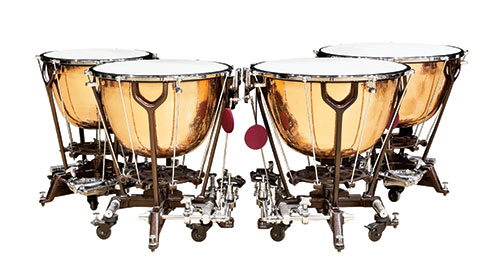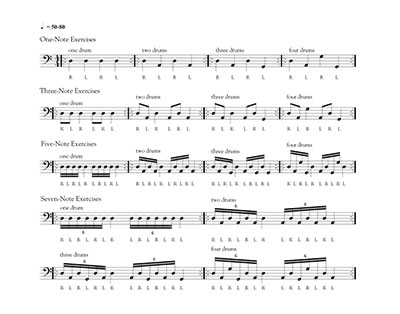Playing timpani requires dedication to producing clear, consistent tone quality and articulation. The vibration of the timpani heads creates a unique feel and touch very different from conventional heads used on other drums. Students might assume at first that timpani playing technique is no different than the technique needed to play concert toms, which can cause many percussionists to produce a muddied and unclear sound on the timpani.
To further emphasize this, I refer to one of the most frequently asked timpani excerpts on professional orchestra auditions: the opening to the first movement of Wolfgang Amadeus Mozart’s Symphony No. 39 in Eb Major, K. 543.

Symphony No. 39 in Eb Major, K. 543 by Wolfgang Amadeus Mozart
Although not as dense or rhythmically busy as other popular timpani excerpts such as the second movement of Paul Hindemith’s Symphonic Metamorphosis or the ending of Igor Stravinsky’s Rite of Spring, Mozart 39 is difficult to execute at a high level because every note must be played with the same tone and articulation in an exposed setting, whether in an audition or a full orchestra. I tell my students that of all the standard timpani excerpts, Mozart 39 might be the most difficult to master.
When first teaching timpani technique, it is essential to focus on producing clear, matched articulations in both hands. Additionally, students must establish an awareness of their tone and articulation so that they are able to recognize their articulation deficiencies and adjust accordingly on their own without instruction.

Exercises
I have written the exercises below to help students develop consistent tone and articulation on the timpani. The main objective is to make every note played on the timpani sound the same. These pitches were selected because they are in the middle of the optimal range for each drum. The exercises start with one drum and gradually add more drums, all while maintaining the same rhythm. In addition, the exercises follow a natural progression in rhythmic density from one to seven notes at a time.

Tone and Articulation Exercises for Timpani
Practicing Tips
The slow tempo range of 50-80 beats per minute was a deliberate choice to give students enough time to assess the sound produced by each timpani stroke. These exercises are meant to be used to improve sound quality, rather than build chops and speed. Therefore, encourage your students to play these exercises slowly.
There are multiple schools of thought on grip and stroke technique. I recommend an approach that will maximize the benefit of these exercises. Prior to playing, hold both mallets completely vertical and perpendicular to the floor. After striking the timpani once, return the mallet to its vertical rest position. Do not strike with the opposite hand until the first hand has returned to rest. This is to ensure a consistent lift stroke from each mallet and to avoid any inadvertent downstrokes.
When teaching these exercises to my students, I tell them to lead with their ears rather than leading with their hands. The objective of playing the exercises is to improve consistent tone and articulations. Although producing a good sound on the timpani is a learned skill, even beginning percussion students can hear whether or not the articulation played from the right hand to the left hand match, as well as whether or not the example of tone they produce matches the tone produced by their teacher. Using the ears to improve tone is an especially valuable skill to learn and will serve students greatly as they continue their musical development because at the end of the day, it is all about the sound. As I always say to my students, technique is a means to make music, but technique is not music.
Mallets are made of varying materials and have varying degrees of hardness, so students should play these exercises with different types of timpani mallets. Each timpani mallet will have a unique feel and range of articulation, which means that the way to produce an ideal tone and articulation will vary. Practicing with different mallets will prepare students to achieve the best tone and articulation, regardless of how soft or hard a mallet is.
Conclusion
These exercises and concepts can be a gateway to teaching timpani technique to your students. Timpani should be approached with the same high standards we have for snare drum, mallet percussion, and drumset. The instrument provides students with important skills and concepts necessary for developing musical excellence in ways that are unique to it.






